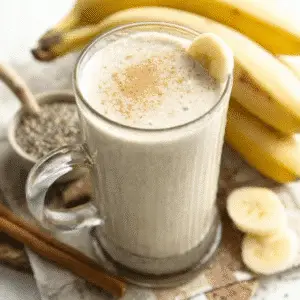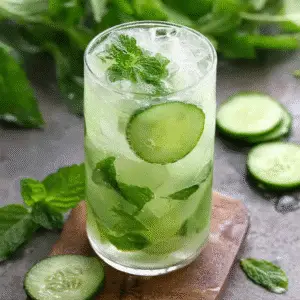🖋️ Written by Olivia
It started with a whisper on social media. A screenshot. A comment. A TikTok clip claiming a “Japanese morning drink” was the reason someone dropped ten pounds in two weeks. Curious and half-awake, Mia scrolled through Reddit at 6 a.m., pausing on a thread titled: “Anyone tried the Japanese pink salt recipe?”
It didn’t look complicated. Just warm water, a bit of pink Himalayan salt, maybe lemon or apple cider vinegar. Some called it a hydration hack. Others swore it helped with weight loss and bloating. The buzzwords were everywhere — diet, detox, digestion, glowing skin.
But was there truth behind it?
She screenshot the search, bookmarked a few posts, and headed to her kitchen. What started as a curious scroll turned into a daily ritual. The results? That’s where the story gets interesting.
In this article, we’ll unpack the viral Japanese pink salt recipe, what it really does, how to make it, and whether it’s worth the hype — or just another social media myth dressed as wellness advice.
Table of Contents
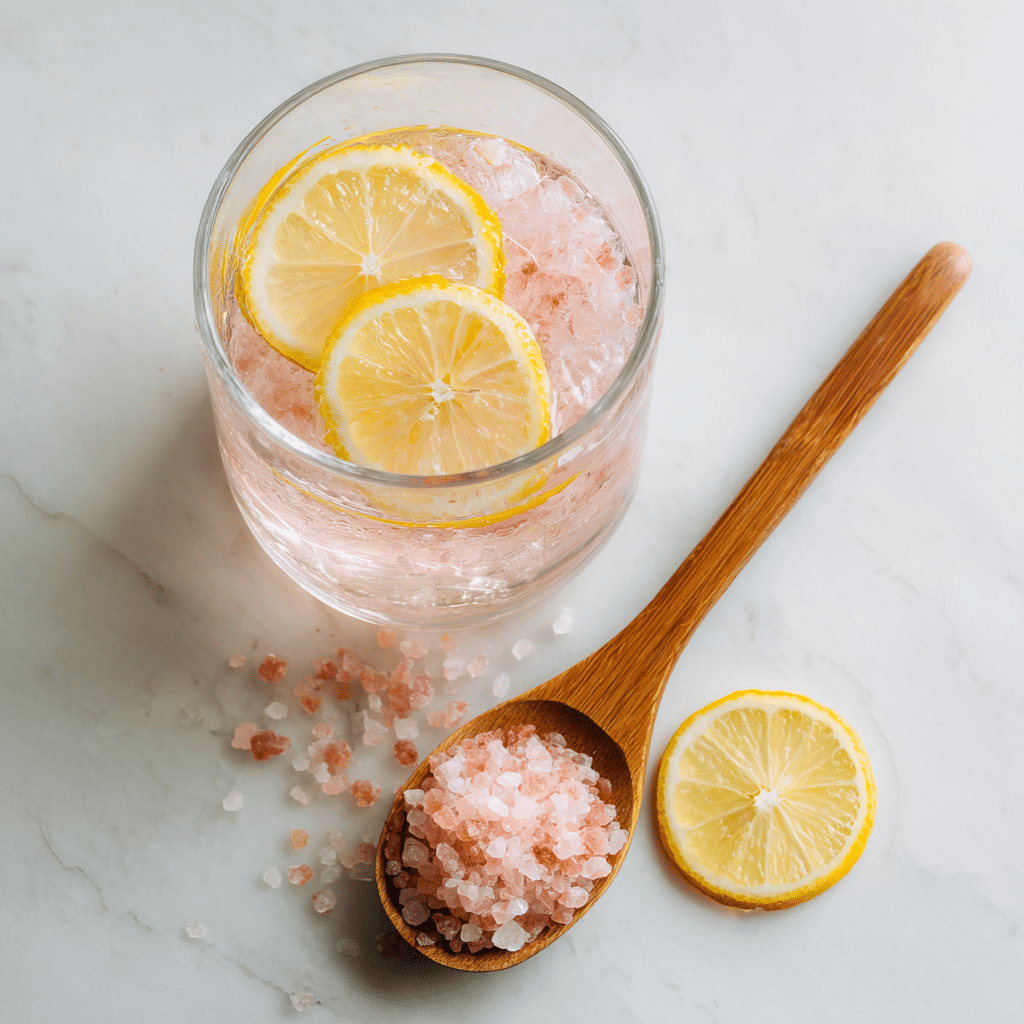
Japanese Pink Salt Morning Drink
Ingredients
Equipment
Method
- Heat filtered water until warm (not boiling), around 100°F (38°C).
- Add pink Himalayan salt and stir until fully dissolved.
- Add optional lemon juice, apple cider vinegar, or baking soda if desired, then stir to combine.
- Drink immediately, ideally within 30 minutes of waking for best hydration effect.
Notes
What Is the Japanese Pink Salt Recipe?
Japanese pink salt recipe explained
The Japanese pink salt recipe is a morning hydration drink that blends warm water with pink Himalayan salt, and optionally, lemon juice or apple cider vinegar. This simple formula has become a morning ritual for many seeking improved hydration, digestion, and even fat-burning support.
The classic version looks like this:
- ½ teaspoon pink Himalayan salt
- 1–2 cups warm filtered water
- Optional: 1 tsp of lemon juice, baking soda, or ACV
Thanks to its trace minerals like potassium and magnesium, this drink is believed to quickly restore electrolyte balance and reduce bloating when taken after waking up.
Some people combine it with lemon or vinegar to create a stronger morning detox tonic, hoping to improve gut function or reduce cravings.
Common myths and online trends
Influencers often exaggerate what the drink can actually do. Claims like:
- “Flush toxins in 1 day”
- “Burn stubborn belly fat overnight”
- “Lose 10 lbs in a week with pink salt water”
…spread quickly online but aren’t backed by clinical research.
What’s more realistic is this: drinking this mix might help you feel full, manage early appetite spikes, and hydrate more effectively. Some people combine it with natural pink salt Mounjaro alternatives to mimic the GLP-1 effects from medications like Zepbound or Ozempic.
Still, don’t expect miracles from saltwater. What it can do is support hydration, reduce water retention, and help with light morning digestion if used responsibly.
Ingredients Behind the Japanese Pink Salt Recipe
Japanese pink salt recipe ingredients list
The Japanese pink salt recipe stands out for its simplicity. It requires only a few ingredients, all of which are easy to find and often used in home wellness routines.
Here’s a basic version of the recipe:
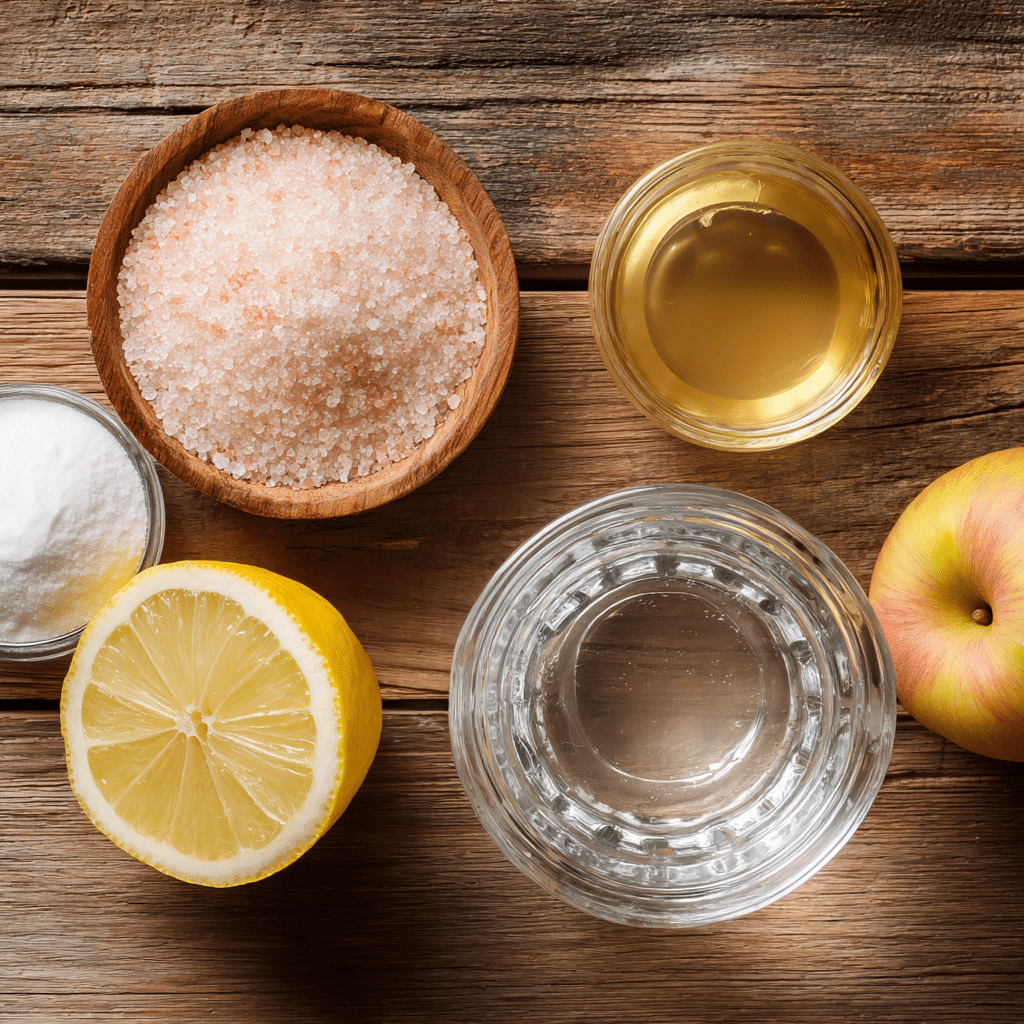
| Ingredient | Function |
|---|---|
| Pink Himalayan Salt | Electrolyte support, mineral replenishment |
| Filtered Warm Water | Hydration and absorption |
| Lemon Juice (optional) | Alkaline balance, flavor boost |
| Apple Cider Vinegar (optional) | Supports [**metabolism**](https://bestyrecipe.com/pink-salt-apple-cider-vinegar-weight-loss-recipe/), gut health, and [**detox routines**](https://bestyrecipe.com/apple-cider-vinegar-detox-drink/) |
| Baking Soda (optional) | pH regulation and mild digestive aid |
The main ingredient, pink Himalayan salt, is rich in trace minerals like potassium, calcium, and magnesium. These nutrients play a role in electrolyte function and hydration. Drinking this mix first thing in the morning may help replace what’s lost overnight, especially in warmer climates or after poor sleep.
Some wellness enthusiasts add it to their morning Mounjaro routine to support energy and water balance.
Why baking soda, lemon, or ACV are often included
Each optional ingredient in the Japanese pink salt recipe serves a functional purpose.
Lemon juice adds a burst of flavor and may help support alkalinity balance. Apple cider vinegar, widely used in wellness drinks, has been associated with appetite control and fat metabolism. It’s often paired with salt in many pink salt detox recipes because of its reputation for supporting gut health.
Baking soda, when used sparingly, may assist with digestion by neutralizing stomach acid. It’s especially useful for people combining this drink with a high-protein diet or intermittent fasting.
Some even combine this formula with ingredients from natural Zepbound alternatives to boost results while avoiding harsh commercial fat burners.
When blended properly and taken in the right timing, this recipe can become a helpful part of a balanced health plan — not a shortcut, but a small daily upgrade.
How to Make the Japanese Pink Salt Recipe at Home
Step-by-step preparation instructions
Making the Japanese pink salt recipe at home is quick and easy. The goal is to create a mineral-rich drink that supports hydration, especially after sleep. Here’s the most common way to prepare it:
Ingredients:
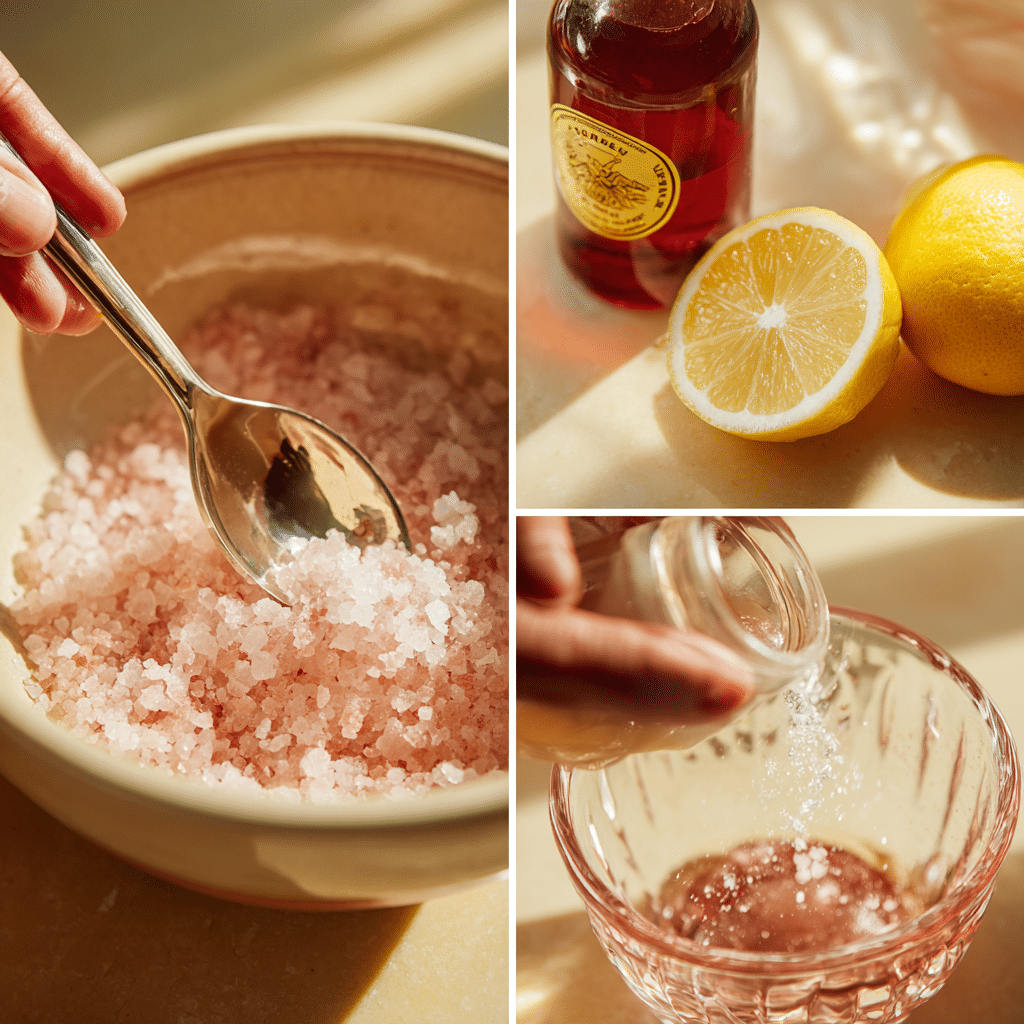
- ½ tsp pink Himalayan salt
- 1–2 cups warm filtered water
- Optional: 1 tsp lemon juice
- Optional: 1 tsp apple cider vinegar
- Optional: a pinch of baking soda (for pH support)
Instructions:
- Heat the water until it’s warm but not boiling — around 100°F (38°C)
- Add the pink salt and stir until completely dissolved
- If using lemon or ACV, add it now and mix again
- Drink immediately, ideally within 30 minutes of waking
Some users like to sip this slowly while journaling or stretching. Others add it to their morning hydration habit to start the day with balanced minerals and improved focus.
The warm temperature helps the body absorb minerals faster and soothes the digestive tract. If using baking soda, keep the amount small to avoid a metallic aftertaste.
Tips to maintain correct dosage and timing
A common mistake is using too much salt. You only need a small amount — ½ teaspoon is more than enough for one cup of water. Higher amounts may lead to bloating or excess sodium intake.
Drink the recipe first thing in the morning, on an empty stomach, before coffee or food. This helps the body absorb nutrients more effectively and supports natural hydration before your digestive system activates.
For best results, some pair this recipe with appetite-balancing routines or natural fat-burning drinks. Avoid adding sugar or sweeteners — it’s meant to be mineral-based and simple.
If you’re also doing intermittent fasting or keto, this drink can help reduce lightheadedness by providing sodium and potassium, often lost overnight.
Those seeking stronger effects sometimes combine it with ingredients found in homemade pink salt detox blends or Mounjaro-inspired recipes that mimic metabolic support.
Japanese Pink Salt Recipe for Weight Loss – What Science Says
Is the pink salt trick effective for fat burning?
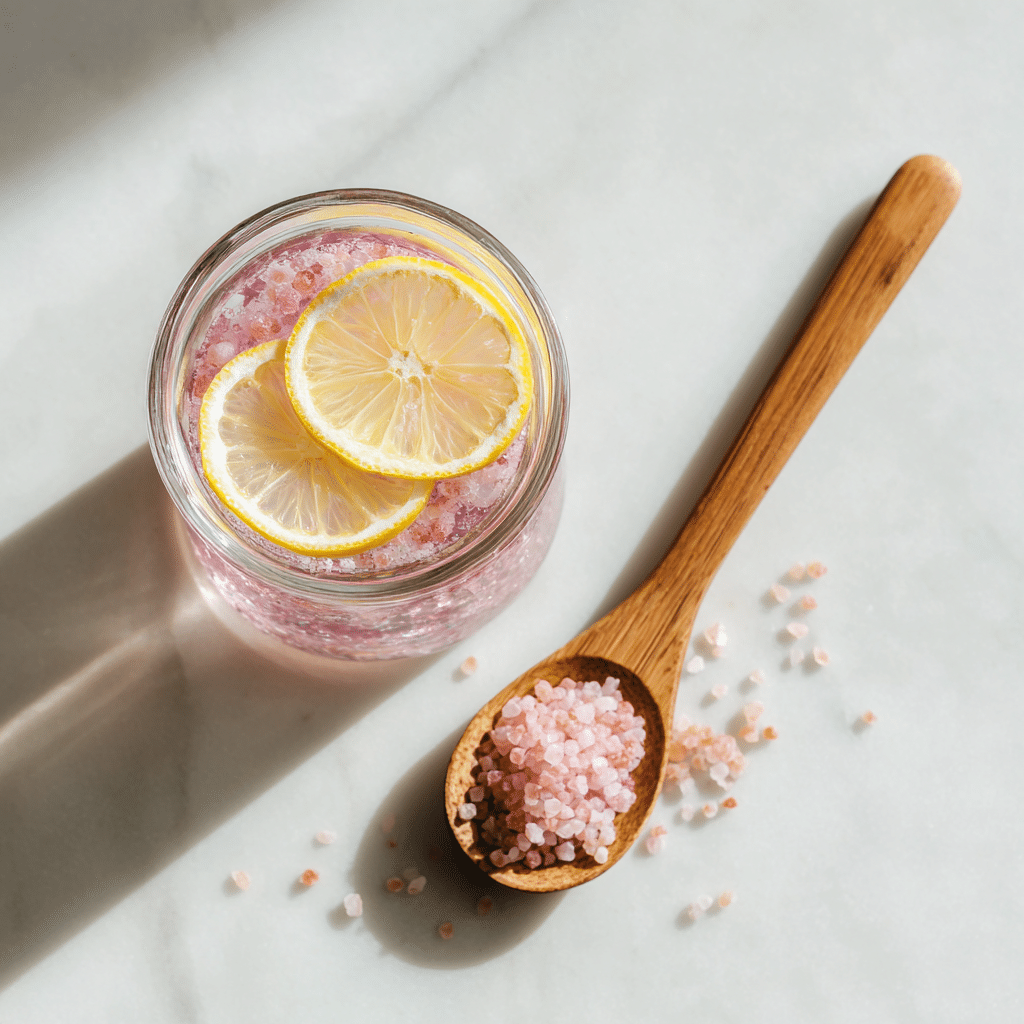
Many people turn to the Japanese pink salt recipe because of claims that it melts fat, suppresses appetite, and triggers rapid weight loss. These claims are popular online, but do they hold up?
Pink Himalayan salt does contain trace minerals like potassium and magnesium, which may support electrolyte balance. But there’s no scientific proof that salt water alone burns fat or causes the body to lose weight quickly.
What it can do, however, is:
- Improve hydration early in the day
- Support mild appetite suppression when combined with apple cider vinegar
- Help reduce bloating and water retention
Some users say they feel lighter and more energized after drinking it, especially when following low-carb or fasting protocols. While this might be true, it’s more about improving digestion and fluid balance — not direct fat burning.
Others combine it with ingredients found in homemade Zepbound-style recipes to boost satiety and curb cravings in the morning.
The drink may assist with supporting your metabolism, but don’t expect it to replace a meal plan or exercise.
How it compares to the “ice water” and ACV hacks
Compared to other viral weight-loss drinks — like the ice water hack or plain ACV shots — the Japanese pink salt recipe is gentler on the stomach and easier to stick with daily.
Ice water may slightly raise metabolism as the body warms it up, but the effect is small and temporary. Meanwhile, ACV shots are acidic and can irritate the throat or stomach lining if taken alone. That’s why many prefer adding ACV to the salt recipe for a safer, blended version.
In fact, this combination is already used in popular detox blends that support both digestion and mild appetite control.
If your goal is consistent, sustainable weight loss support, this drink can play a role — but only as part of a wider health routine.
Use it to stay hydrated, support cravings early in the day, and reduce water retention. That alone can make a noticeable difference in how you feel and look — even if it doesn’t melt fat directly.
Real Results or Internet Hoax? Reviews and User Experiences
Reddit, forums, and TikTok testimonials
The Japanese pink salt recipe gained serious attention on TikTok and Reddit in early 2024. People began sharing “before and after” pictures, claiming they lost inches off their waistlines just from drinking this mix each morning.
One TikTok user shared, “It’s been two weeks, and I feel less bloated, way more regular, and down five pounds.” Another mentioned using the recipe alongside Mounjaro-inspired drinks and noticed better focus and appetite control throughout the day.
Reddit users often discuss how the drink fits into their intermittent fasting schedule. Some claim that using it in the morning helps curb snacking and improves gut comfort. A few even paired it with apple cider vinegar detoxes and natural GLP-1 style teas for better effect.
While experiences vary, a common theme appears: it works best when part of a routine, not a standalone “magic fix.”
People who followed structured plans — like the pink salt weight loss version or detox-focused variants — reported more noticeable results.
Medical experts and nutritionist opinions
Most health professionals agree that pink salt water isn’t harmful if used in moderation — especially if you’re not exceeding your daily sodium limits. However, they also caution that it’s not a fat-burning formula.
According to registered nutritionists, the benefits come primarily from improved hydration and possibly better electrolyte balance. Some acknowledge it may assist with morning energy and digestion, especially for those waking up dehydrated or following low-sodium diets.
But warnings exist. Drinking it too frequently or using too much salt can raise blood pressure or cause fluid retention. This is why experts recommend following milder versions like the morning tonic recipe instead of high-sodium versions.
In short: yes, many real people have shared genuine benefits. But it’s not magic — and it’s definitely not a substitute for balanced nutrition, physical activity, and real medical guidance.
If you’re considering using the Japanese pink salt recipe, treat it as a tool, not a shortcut. It may improve hydration, reduce bloating, and support your daily habits — but only if used wisely.
Side Effects of the Japanese Pink Salt Trick
Can daily pink salt cause harm?
While the Japanese pink salt recipe is often described as safe and “natural,” that doesn’t mean it’s free of side effects. Just like any health trend, overuse or improper use can backfire.
The primary concern is sodium intake. Pink Himalayan salt may be less processed than table salt, but it’s still sodium. Drinking this mix every morning — especially in high amounts — can increase blood pressure, raise fluid retention, or cause discomfort in people with salt sensitivity.
Some users report feeling:
- Bloated
- Nauseous
- Light-headed
- Slightly flushed
These side effects usually occur when too much salt is used, or when it’s consumed without proper balance.
For safer results, stick to no more than ½ teaspoon of salt per 1–2 cups of water. This helps minimize risks and still provides enough minerals for hydration. If you’re already getting sodium from other meals, adding this drink might be unnecessary.
People with kidney conditions, high blood pressure, or cardiovascular concerns should avoid salt-based drinks unless advised by a healthcare provider.
For those with sensitive digestion, it’s better to use a gentler version like the pink salt morning tonic or switch to a lower-sodium detox drink that still supports hydration and digestion.
Electrolyte imbalances, dehydration, and other concerns
Ironically, if the Japanese pink salt recipe is used too often, it can create the very problems it claims to solve — such as dehydration or electrolyte imbalance.
When sodium levels rise without sufficient water intake, your body may pull fluids from cells, making you feel dry or dizzy. Over time, this can stress your kidneys or elevate blood pressure, especially if paired with a salty diet.
Excessive use may also disrupt your natural electrolyte cycle, particularly in warmer climates or during workouts.
To avoid this, some people rotate it with lighter options, such as lemon detox water or apple cinnamon detox drinks, which hydrate without salt overload.
Remember, moderation is key. Pink salt may help with fluid balance, but more isn’t better — especially if you’re already eating processed foods or using other salt-based supplements.
Use it wisely. Listen to your body. And if you experience symptoms like swelling, dry mouth, or dizziness, stop the recipe and consult a professional.
Alternatives to the Japanese Pink Salt Drink
Sea salt vs Himalayan pink salt: Which is better?
Many people ask if they can swap out pink salt for sea salt in the Japanese pink salt recipe. Technically, yes — but there are differences to consider.
Himalayan pink salt comes from ancient sea beds and is hand-mined, often containing trace minerals like magnesium, calcium, and potassium. These minerals are what make it popular in wellness drinks. On the other hand, sea salt is harvested from evaporated ocean water and may contain microplastics or additives, depending on its source.
In terms of health impact, both are still sodium chloride. The slight mineral difference is minimal unless you’re using unrefined, high-quality versions.
If you’re looking for hydration support, the best choice is still pink salt — as found in the pink salt morning tonic and detox blends where balance is more important than taste.
That said, if you’re out of pink salt, a pinch of unprocessed sea salt can serve in a pinch — but it won’t carry the same mineral variety or smooth flavor.
Healthier morning hydration drinks (with recipes)
Not everyone enjoys salty drinks in the morning. If you’re looking for gentler or tastier alternatives, several morning detox drinks and infused waters offer similar hydration benefits — without the sodium load.
Here are some popular substitutes:
- Lemon-berry detox water – Adds antioxidants and vitamin C
- Apple-cinnamon detox drink – Warmer flavor, supports digestion
- Mounjaro-inspired drinks – Focused on appetite support and gut balance
- Cucumber-lemon detox water – Ideal for hot weather and hydration
Some users prefer starting with a pink salt recipe for 3–5 days, then switching to a fruit-based detox drink. This approach gives the benefits of electrolytes without pushing sodium too far.
In fact, combining routines like the Japanese pink salt recipe in the morning and a low-sodium detox drink in the evening is a common strategy among wellness bloggers and intermittent fasting fans.
The key is consistency. Whether you prefer salty or citrus-based hydration, pick what supports your digestion, energy, and daily flow best.
How to Use Pink Salt for Health Without the Hype
Pink salt hydration tips for daily use
The internet loves extremes. But when it comes to the Japanese pink salt recipe, balance is everything. This drink works best as part of a daily hydration habit — not a detox miracle or instant fat-burning hack.
To get the most out of it, follow these simple tips:
- Use no more than ½ teaspoon of pink salt per 1–2 cups of water
- Drink it first thing in the morning, on an empty stomach
- Stick with warm filtered water — not cold or boiling
- Avoid adding sugar, honey, or commercial flavorings
- Rotate with low-sodium detox waters to avoid over-salting
If you’re using it to support hydration while fasting or dieting, combine it with appetite-friendly drinks and whole foods. Pink salt alone won’t regulate your hormones or suppress cravings — but it can help control early-day hunger when paired with proper fuel.
The recipe also fits well into intermittent fasting routines where electrolytes are often depleted during long fasting windows.
Avoiding exaggerated claims and focusing on balance
Let’s be clear: no drink will melt fat overnight. The Japanese pink salt recipe isn’t a magic fix — but it’s not useless either.
When used correctly, it supports:
- Morning hydration
- Electrolyte balance
- Mild appetite control
- Reduced bloating
That’s a strong list — especially for something so simple. But the key is avoiding extremes. Drinking too much salt water, skipping meals, or depending solely on pink salt for weight control can backfire.
Instead, use this drink as a tool. Add it to your morning to support metabolism. Follow it with clean meals and stay consistent with your hydration goals.
If you want to take it further, explore fat-burning blends or rotate with natural detox infusions like apple-cider vinegar recipes.
Simple is powerful — but only when backed by good habits and long-term thinking.
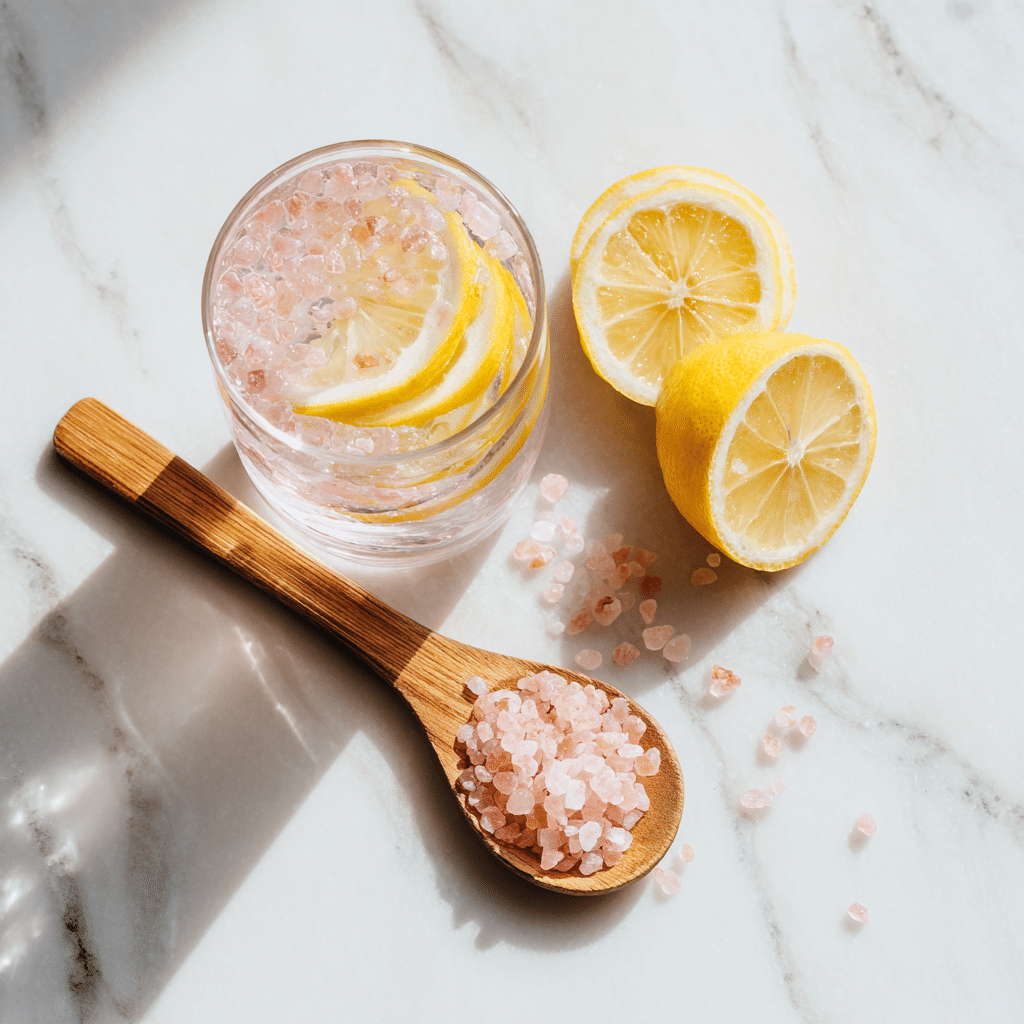
FAQs – Japanese Pink Salt Recipe
How much pink salt should I put in my water in the morning for hydration?
Use ½ teaspoon of pink Himalayan salt in 1 to 2 cups of warm filtered water. This amount is enough to support hydration without overwhelming your sodium intake.
How does apple cider vinegar help you lose weight?
Apple cider vinegar may reduce appetite and improve insulin sensitivity, which supports fat metabolism. It’s often added to the pink salt weight loss recipe for enhanced digestion and hunger control.
What is the secret salt test?
This refers to a viral method where individuals assess hydration by drinking pink salt water and observing changes in energy or bloating. While not scientific, it’s used to “test” how your body responds to added minerals.
What is the magic salt trick?
The “magic salt trick” is a nickname for the Japanese pink salt recipe — a mix of warm water and pink Himalayan salt. Some add ACV or lemon to boost its fat-burning support, especially in the morning.
Can I drink pink salt water every day?
Yes, in moderation. Limit to once daily using a small amount of salt (½ tsp max). Overuse may raise sodium levels or cause side effects.
What does drinking salt water before bed do?
Some believe it calms nerves or prevents leg cramps. But drinking salt water at night may also disrupt sleep or increase thirst. Morning is the recommended time for the pink salt tonic.
What is better for hydration, pink salt or sea salt?
Pink Himalayan salt is less processed and contains more trace minerals than typical sea salt. It’s a more popular choice in natural hydration drinks.
What is the 4 ingredient pink salt trick?
The common 4 ingredients are: pink Himalayan salt, warm water, lemon juice, and apple cider vinegar. This blend is popular for detox and metabolism support.
What is the pink salt trick for weight loss recipe?
It’s a simple morning drink using pink salt, warm water, lemon, and sometimes ACV. It supports hydration, appetite control, and reduces bloating.
Does the pink salt trick actually work?
It supports hydration and mineral balance, especially when paired with clean eating. It’s not a fat burner by itself but complements weight loss routines well.
Does the pink salt diet actually work?
The pink salt diet focuses on low-sodium meals and natural hydration. Results vary, but when used with a healthy lifestyle, it can improve energy and digestion.
How did Adele lose weight?
Adele followed a calorie-controlled diet and regular workouts. Some fans link her results to hydration strategies like the salt water trick, but nothing is confirmed.
What is the ice water hack for weight loss recipe?
Drinking cold water may cause the body to use extra energy warming it. Some combine the ice hack with pink salt or ACV to boost morning fat-burning routines.
What are the side effects of Himalayan pink salt?
Too much can lead to bloating, water retention, or high sodium levels. Side effects often appear with overuse or poor hydration.
What does pink salt and lemon water do?
This combo may support digestion, detox, and hydration. It’s often used in the morning to reduce bloating and restore minerals after sleep.
Conclusion
The Japanese pink salt recipe isn’t just another wellness fad. While it’s not magic, it can serve as a valuable morning habit — especially for those looking to improve hydration, manage cravings, or feel less bloated.
Used responsibly, it offers:
- Better mineral balance
- Digestive support
- Morning energy without caffeine
- A natural addition to fat-burning routines
But it’s not a weight-loss miracle. Think of it as a helper — not a hero. Whether you’re using it with ACV, lemon, or part of a natural Mounjaro-style routine, the key is moderation and consistency.
Start small. Listen to your body. And always choose realistic habits over viral shortcuts.
Hungry for more? Discover fresh recipes every day on BestyRecipe’s Pinterest & Facebook!

